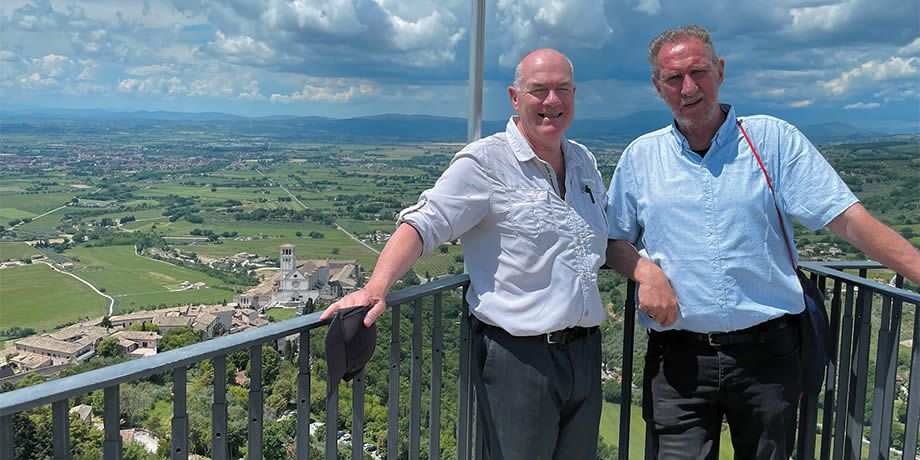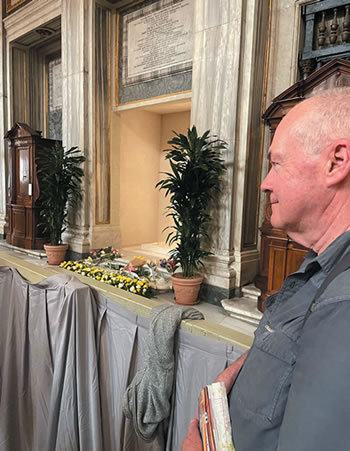
“John, how would you fancy coming with us on a trip to Rome and Assisi?” This was the lovely invitation I received from my good friends and long-time Columban supporters Dave and Sue back in January 2025. Of course, I jumped at the chance. “When would be best for you?” they asked. We compared diaries and decided the most convenient date for starting the journey would be on May 8.

Does Thursday, May 8, 2025, sound familiar? It was the day Robert Prevost was chosen by the Conclave as the new Pope, taking the title Leo XIV. The cardinals had made their choice, but it appeared we’d stolen a march on them. We were already on our way to Rome.
I thought about this as we joined the crowds in St. Peter’s Square to await the first Sunday Blessing by the new Pope. I began to realize how we Columban missionaries have had a habit of anticipating Papal events.
Take, for example, Leo’s predecessor, our beloved Pope Francis. In 2013, he’d inspired the world with his encyclical “Laudato Sí” showing how combined care of the natural and social environment—our “common home”—was a spiritual and human imperative. Yet, in many respects, Columban Fr. Sean McDonagh had already pointed out much of this more than twenty years before in his seminal work, “The Greening of the Church” (1990).
Pope Francis tirelessly emphasized the dignity and equality of every person in society, irrespective of gender, class or ethnic background. He fostered greater participation in the Church by all men and women, not just ordained male priests, culminating in the 2023-25 Synodal process. However, in a way, Columban missionaries had been doing the same for years. I remember that, when I arrived in what was to be my mission country of Peru in 1994, I was delighted to find how the Columban missionaries were promoting lay involvement in liturgy, pastoral work and decision-making throughout our missions.
Indeed, a common refrain I heard during my time in Peru was along the lines of, “You Columbans, you were Francis before Francis!”

Meanwhile, back on our travels, we continued to find ourselves one step ahead of “Pope Bob.” Incidentally, it hadn’t been lost on me that, not only had the new Pope been a friend and collaborator of Pope Francis, but he’d also been a missionary at the same time and in the same country as myself—Peru. On Saturday, May 10, we decided to join the multitudes praying at the tomb of Pope Francis in Rome’s Basilica of Santa Maria Maggiore. As we were leaving, we noticed the police closing off the approach road to traffic. Soon, a small cavalcade arrived, escorting none other than the new Pope, who was coming to pay his respects at Pope Francis’s tomb. We’d beaten him to it by 40 minutes!
Soon after, we left for the wonderful hilltop medieval town of Assisi, famous as the home and resting place of St. Francis (inspiration of the late Pope who’d taken the saint’s name as his own). Along with the other pilgrims, we visited the tomb of St. Francis and the shrine of his companion in faith and vocation, St. Clare. We then proceeded to a third—and very recent—shrine: the resting place of Blessed Carlo Acutis (1991-2006), located in yet another church dedicated to Mary as Santa Maria Maggiore.
The story of Carlo Acutis — variously called a future “saint for our times,” or “the teenage saint” — is a fascinating one. He was born in London to Italian parents, who soon moved the family back to Italy, where the young Carlo grew up and was consumed by two passions—Jesus and the internet. He became well known both as a “computer geek” and a catechist. He combined them by launching a Catholic website in 2004. The initiative culminated in an exhibition unveiled on October 4, 2006, the feast of St. Francis of Assisi — just days before Carlo himself tragically died from leukemia. Beatified in 2020, his canonization was planned for April 27, 2025, during the teenagers’ Jubilee, but had to be postponed due to the death of Pope Francis the week before.
Later, we met one of the volunteers who accompanied pilgrims to Assisi. He assured us they were eagerly awaiting the announcement of a fresh date for the canonization and the arrival of the new Pope at the shrine.
Once again, it seemed we’d anticipated a pontiff’s future move.
But that’s the Columban missionaries all over. Always in step with the Papacy… and sometimes even a step ahead.
Columban Fr. John Boles lives and works in Britain.
Why Did the Pope Choose the Name Leo?
Many thought that the new pope would take a name in honor of an illustrious recent predecessor, such as “John Paul” or “Francis.” However, he opted for Leo. Why “Leo”?
Apparently, the immediate explanation that Robert Prevost gave his fellow cardinals was that he — like Pope Francis before him — had been inspired by the example and teachings of Pope Leo XIII (1878-1903). This was the first pope to take seriously and champion the rights of the working class, which was suffering the adverse effects of the Industrial Revolution. In 1891, he published the papal encyclical “Rerum Novarum,” widely seen as the foundation stone of Catholic Social Teaching. Prevost has shown a deep concern for social justice and has been particularly worried about the impact that artificial intelligence might have on the rights of workers.
However, it seems a secondary influence might have been the life of the thirteenth-century Franciscan known as “Brother Leo.” This Leo had reputably been the most trusted companion of St. Francis of Assisi. After St. Francis’s death in 1226, Leo had fought to maintain the saint’s principles of poverty and humility. He’d opposed the plan to construct a basilica in Assisi, criticized what he saw as the drift of the Franciscans towards “worldliness,” retreated to the life of a hermit, and died (like St. Francis) in the simple Porziuncula chapel outside Assisi.
Just as Brother Leo tried to maintain the legacy of St. Francis, the new Pope Leo might be signalling that he’ll try and continue the legacy of Pope Francis...as well as that of his nineteenth-century namesake, Leo XIII. In other words, combining four legacies in one!